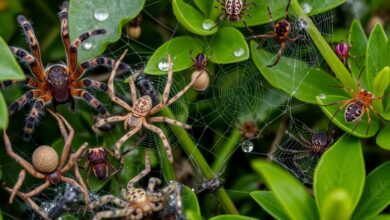Carolina Wolf Spider: Identifying Features and Where to Find Them
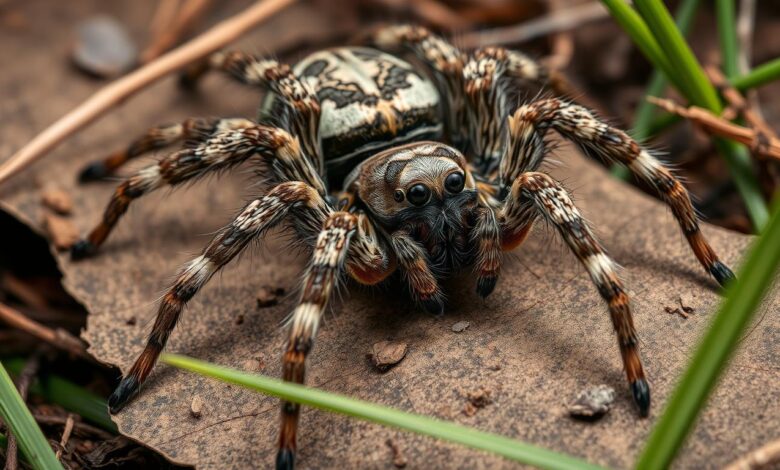
The Carolina wolf spider, known scientifically as Hogna carolinensis, is a big and unique spider found in the southeastern United States. They are known for their size, dark color, and special markings. Knowing how to spot them is important for those who spend time outdoors or garden.
Carolina wolf spiders can have a leg span of up to 2 inches. They are about 1 to 2 inches long, with females being a bit bigger than males. Their dark colors and a violin-shaped mark on their backs make them easy to spot.
These spiders like many outdoor places, like forests, grasslands, and even suburban gardens. They are found in states like North Carolina, South Carolina, and Georgia. Knowing where to look for them can help you enjoy these interesting spiders in their natural homes.
Hogna carolinensis: The Carolina Wolf Spider in Detail
The Carolina wolf spider, or Hogna carolinensis, belongs to the Lycosidae family. They are known for their strong build and hunting skills. These spiders can grow up to 2 inches long, with females being larger than males.
Their bodies are dark brown or black, with unique markings. These markings help distinguish them from other wolf spiders.
Carolina wolf spiders have excellent eyesight. They have eight eyes in three rows, giving them a wide view to spot movement and color. Their agility and speed make them great hunters, chasing down prey with their long legs.
These spiders are mostly active at night. They hunt for insects, other spiders, and small animals like lizards and frogs. Their venom is not harmful to humans, as it’s mainly used to catch prey.
Carolina wolf spiders are known for their maternal care. Females carry their egg sacs until the spiderlings hatch. Then, they protect the spiderlings on their backs. This ensures the survival of the next generation.
Hogna carolinensis is the largest wolf spider in North America. Adult females can be 22–35mm, and males 18–20mm. They are found in many parts of North America, including South Carolina and the Great Lakes. They help keep the ecosystem balanced by controlling insect and small animal populations.
| Key Facts about the Carolina Wolf Spider |
|---|
| Maximum Size: 2 inches in length |
| Habitat: Forests, grasslands, deserts, and suburban areas |
| Diet: Insects, other spiders, small vertebrates |
| Eyesight: Excellent, with eight eyes arranged in three rows |
| Maternal Care: Females carry egg sacs and spiderlings on their backs |
| Venom: Venomous, but not considered a significant threat to humans |
| Activity: Primarily nocturnal, active from March to October |
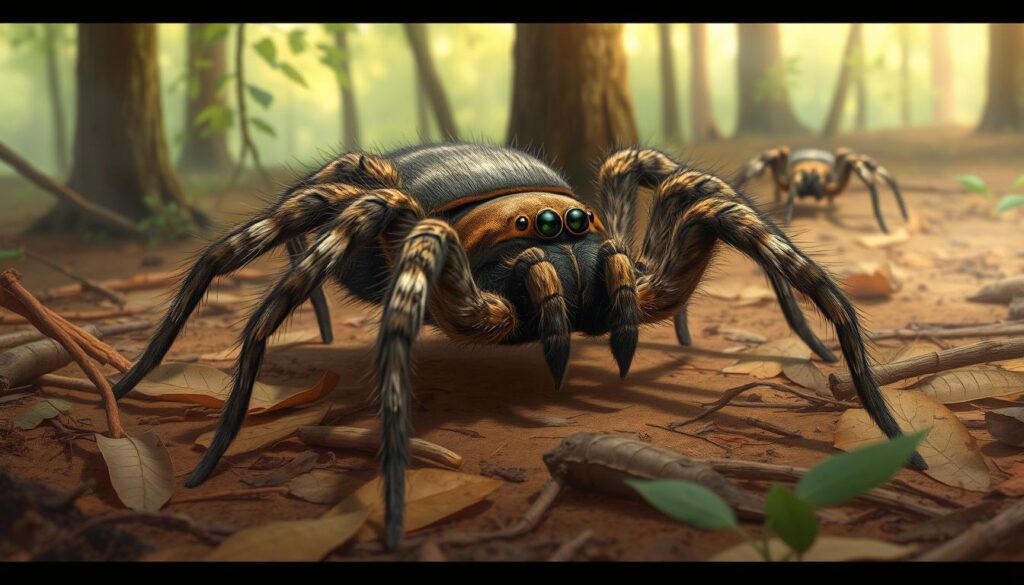
Distinct Markings and Appearance of the Carolina Wolf Spider
The Carolina wolf spider, known as Hogna carolinensis, is well-known in North America. Its unique markings make it easy to spot among other Carolina fauna and wolf spider species.
The Carolina wolf spider has a dark, violin-shaped mark on its cephalothorax. Its legs have bands, setting it apart from other North American wolf spiders. Its body color can be dark brown to black, with lighter patches.
This spider is also big, growing up to an inch long, including its legs. Females are usually bigger than males, a common trait in spider biology and arachnid behavior.
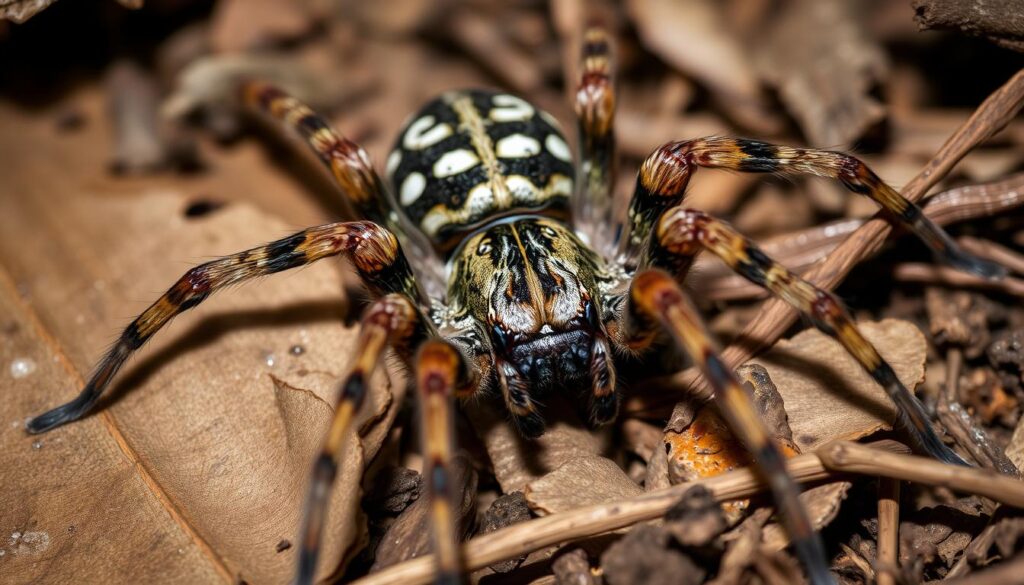
Knowing how to identify the Carolina wolf spider is important for outdoor pest control and gardening. These venomous spiders can be found in many outdoor environments. Understanding their features helps ensure safety and protects the ecosystem.
The Carolina Wolf Spider’s Habitat and Range
The Carolina wolf spider, known as Hogna carolinensis, lives in the southeastern United States. They are found in many outdoor places, like forests, grasslands, urban gardens, and landscapes.
These spiders love places with lots of hiding spots, such as under logs, rocks, or leaf litter. They are also seen around buildings, making them common pests in outdoor areas.
The Carolina wolf spider stretches from North Carolina to Texas. They are important in the Carolina fauna. Learning about their biology and behavior helps us understand their ecosystems better.
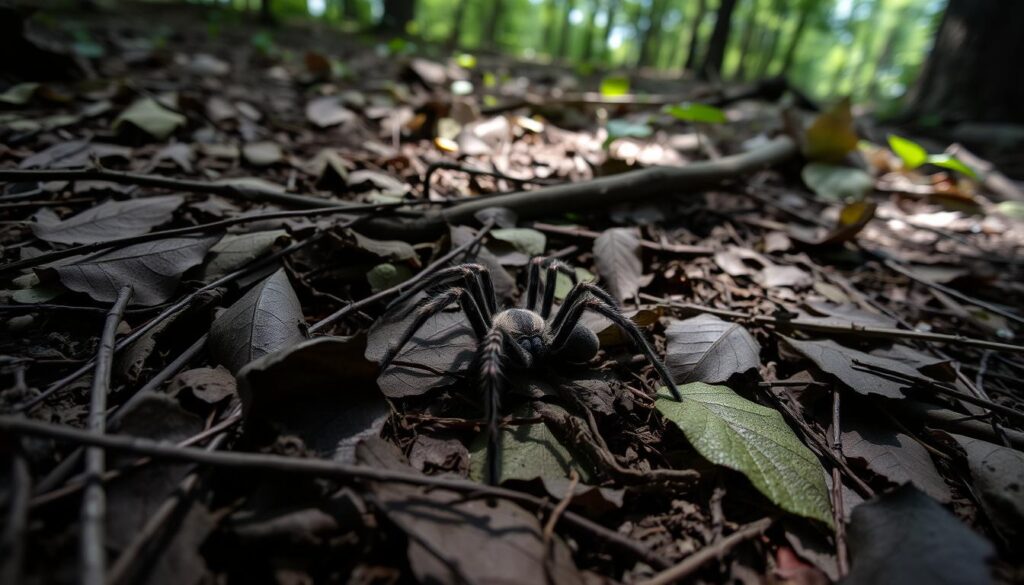
If you love gardening, nature, or just want to know about wolf spider species in North America, the Carolina wolf spider is worth learning about.
Behaviors and Habits of the Carolina Wolf Spider
The Carolina wolf spider, known as Hogna carolinensis, is a skilled hunter. It is part of the wolf spider group in North American arachnids. These venomous spiders have interesting behaviors that help them succeed in the Carolina fauna.
Carolina wolf spiders are ambush predators. They wait patiently in hidden spots, using their great eyesight to spot prey. When prey comes close, they quickly attack, using their speed and agility to catch insects, small invertebrates, and even small vertebrates.
These spiders are also very territorial. They fiercely defend their nesting sites and hunting areas from other spiders. This behavior helps them keep control over their territory, improving their chances of success in outdoor pest control and gardening pest management.
| Behavior | Description |
|---|---|
| Hunting Tactics | Ambush predators, using excellent eyesight to detect prey and pounce quickly |
| Prey Preferences | Insects, small invertebrates, and even small vertebrates like lizards and frogs |
| Territoriality | Aggressively defend their nesting sites and hunting grounds from competitors |
| Mobility | Capable of running at high speeds to catch their prey |
The Carolina wolf spider’s spider biology and arachnid behavior are fascinating. They show how well adapted these spiders are as predators in their natural habitats.
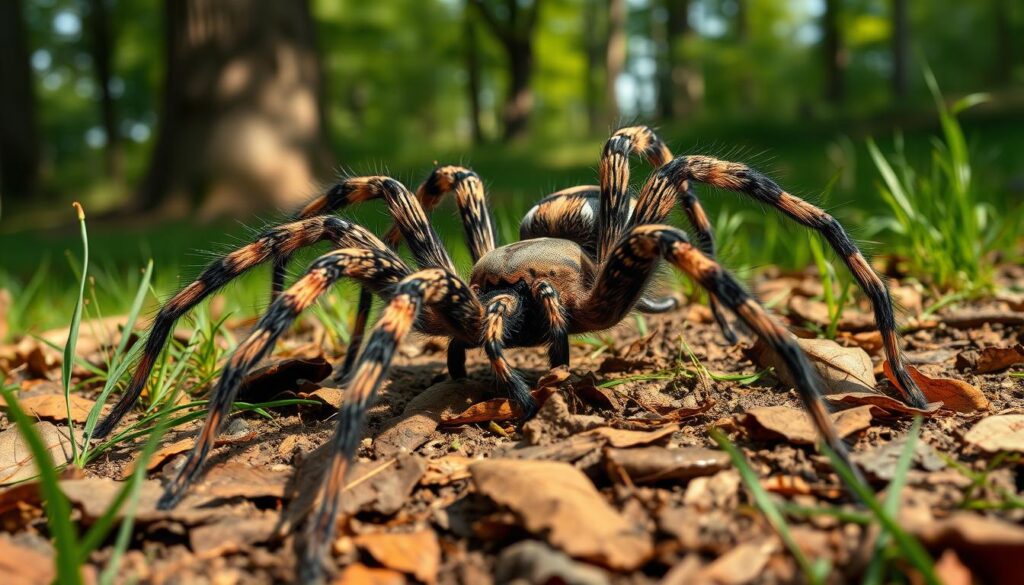
The Role of the Carolina Wolf Spider in North American Ecosystems
The Carolina wolf spider, also known as Hogna carolinensis, is a key predator in the southeastern United States. These large spiders can grow up to 2 inches long. They are important for keeping the local environment balanced and diverse.
As top predators, Carolina wolf spiders control many insects, small invertebrates, and even small vertebrates like lizards and frogs. They eat a wide range of prey. This makes them natural pest controllers, helping gardens and farms stay pest-free.
Carolina wolf spiders can live in many places, from forests and grasslands to suburban areas. Their ability to adapt helps them contribute to the health and stability of their ecosystems.
Maintaining Ecological Balance
By eating many small creatures, Carolina wolf spiders keep insect and invertebrate populations in check. This helps keep the ecosystem balanced, preventing any one species from taking over.
Their role as top predators also supports biodiversity. They prevent any one prey species from becoming too common. This allows for a variety of plants and animals to live together.
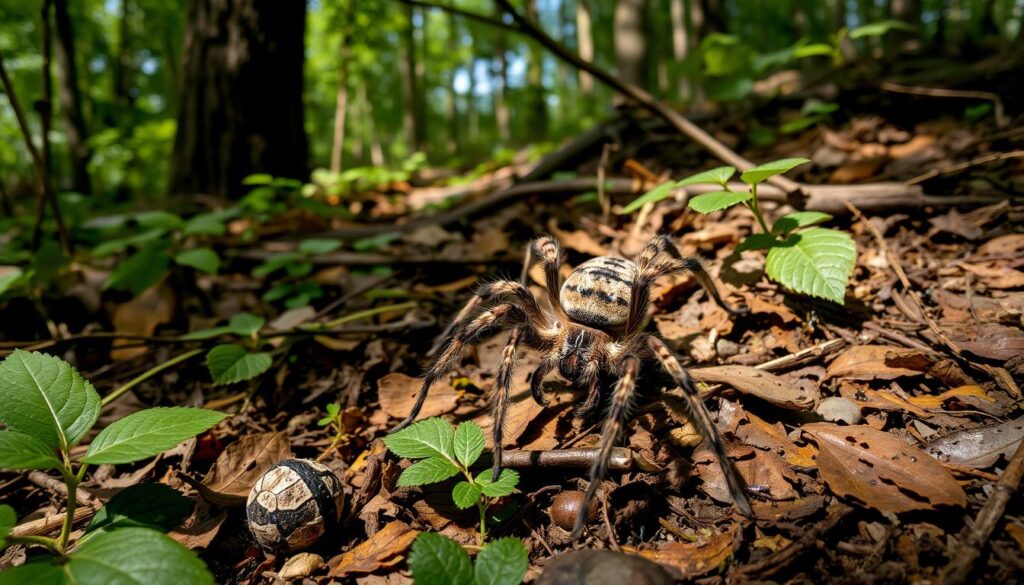
In this way, the Carolina wolf spider is a keystone species. Its actions have a big impact on the health of its ecosystems. Through hunting, it helps keep the environment rich and thriving.
Carolina Wolf Spider: Venomous or Harmless?
The Carolina wolf spider, part of the Hogna carolinensis species, is found in the southeastern United States. It looks scary but is mostly harmless to people. Its venom isn’t strong enough to harm humans.
The spider’s fangs are small, and its venom isn’t dangerous. These spiders usually stay away from people. They only bite if they’re scared or handled. They’re not venomous spiders and don’t pose a big risk to the Carolina fauna.
Seeing a big wolf spider might surprise you, but they’re not aggressive. They like to stay away from humans. Outdoor pest control and gardeners might see them, but they’re not a threat. They play a key role in the ecosystem.
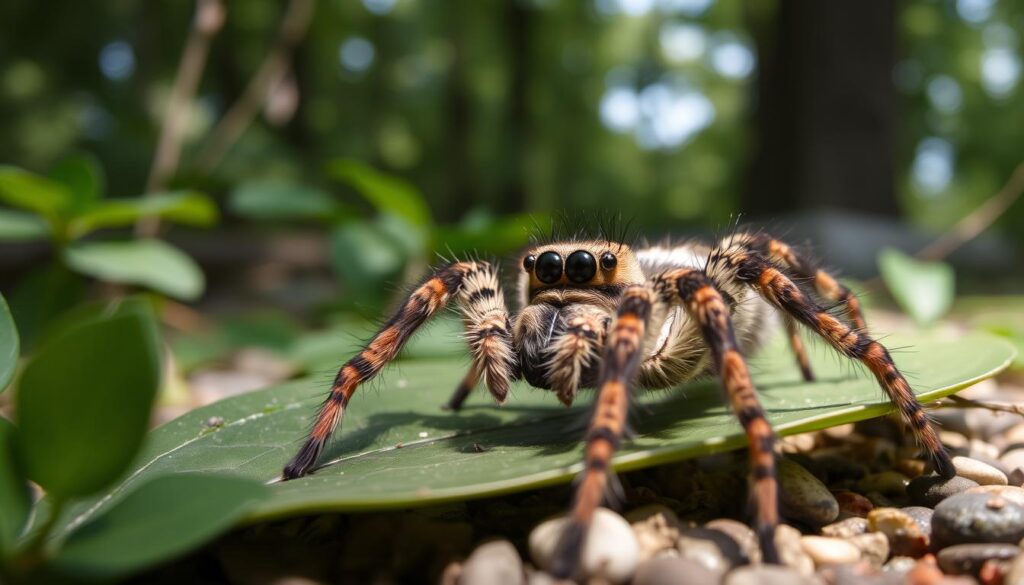
Learning about the Carolina wolf spider’s biology and behavior is important. It helps us appreciate these amazing creatures and their role in nature.
Outdoor Activities and Encounters with the Carolina Wolf Spider
In the southeastern United States, we often see the Carolina wolf spider, Hogna carolinensis. We find them in places like gardens, woods, and grasslands. Knowing how to spot and handle them is key for a safe outdoor time.
The Carolina wolf spider is big and easy to spot. It has a dark violin shape on its body and banded legs. While they are not usually aggressive, it’s best not to touch them. This can make them defensive.
When we see a Carolina wolf spider outside, it’s best to keep our distance. These spiders help control insect and small invertebrate populations. By respecting them, we can enjoy the outdoors safely and peacefully.
Identifying and Responding to the Carolina Wolf Spider
- Recognize the Carolina wolf spider’s distinctive markings, including the dark violin-shaped pattern on its body and banded legs.
- Avoid handling or disturbing the spider, as this can provoke a defensive response.
- Observe the spider from a safe distance and appreciate its role in the local ecosystem.
- Educate others about the Carolina wolf spider and its importance in the natural world.
Knowing about the Carolina wolf spider helps us enjoy the outdoors. With a bit of knowledge and caution, we can live in harmony with these fascinating creatures. This way, we can also appreciate the rich biodiversity of the southeastern United States.
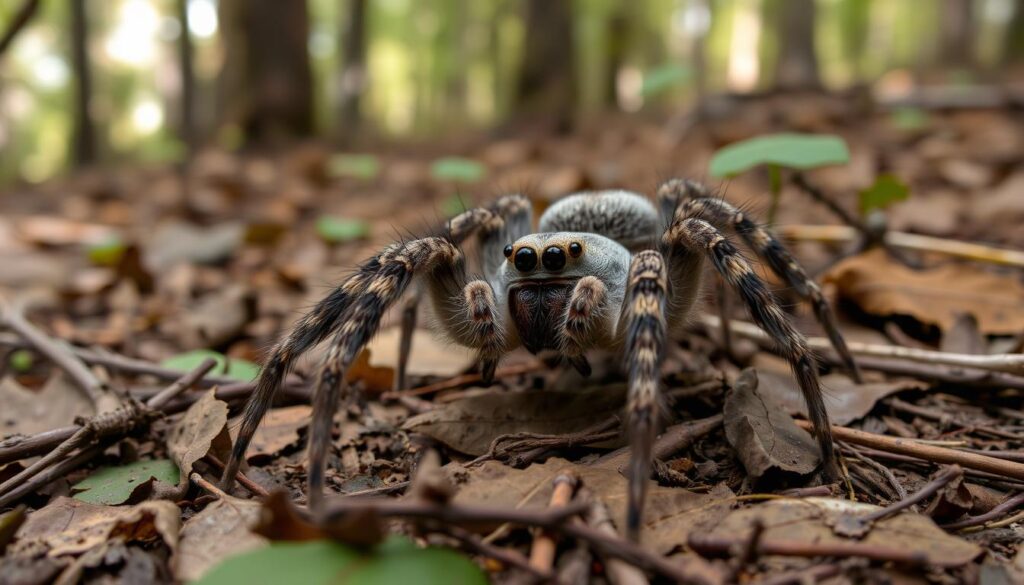
Understanding the Carolina Wolf Spider’s Life Cycle
The Carolina wolf spider, known as Hogna carolinensis, has a unique life cycle. It belongs to the Lycosidae family of wolf spiders. These spiders are key to the Carolina fauna and are found in the southeastern United States.
Females lay their eggs in silken sacs and carry them until the spiderlings hatch. This is a special trait of the Lycosidae family. After hatching, the young spiders start to molt and grow into adults. Carolina wolf spiders can live for many years, with females often living longer than males.
Learning about the Carolina wolf spider’s life cycle helps us understand their behavior and importance. These wolf spider species are vital in controlling outdoor pests and gardening pests. They play a big role in the spider biology and arachnid behavior of the area.
| Life Stage | Key Characteristics |
|---|---|
| Egg Sac | Females carry their egg sacs attached to their spinnerets until the spiderlings hatch. |
| Spiderlings | Young spiders disperse and begin the process of molting and growing into adults. |
| Adult | Carolina wolf spiders can live for several years, with females outliving the males. |
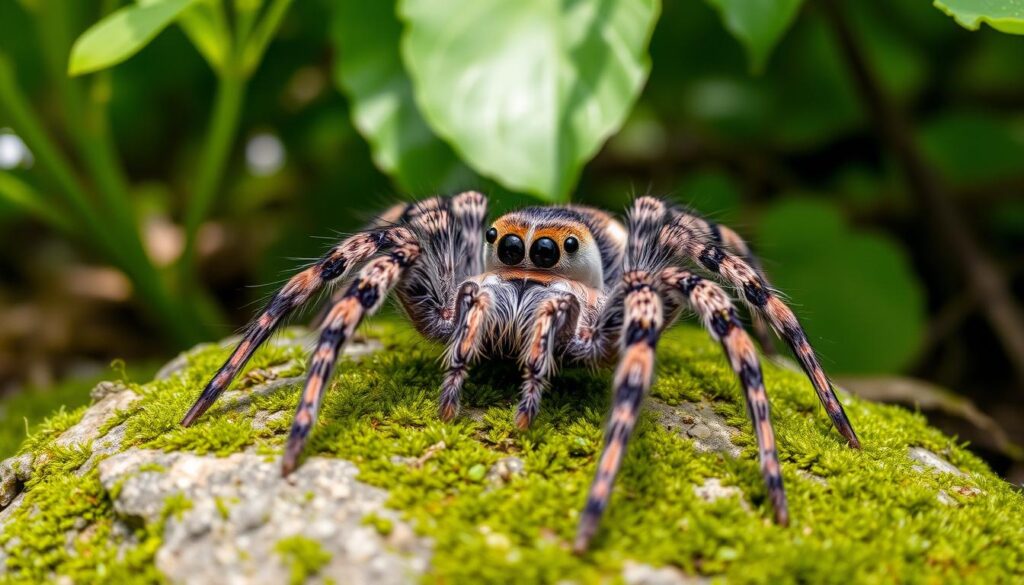
Myths and Misconceptions About Wolf Spiders
There are many myths and misconceptions about the Carolina wolf spider (Hogna carolinensis) and other wolf spiders. It’s important to know the truth to understand these North American arachnids better. This helps us see their true role in their ecosystems.
Debunking the Venomous Myth
Many people think wolf spiders are very venomous and dangerous to humans. But this is not true. While they do have venom, it’s not strong enough to hurt people badly. Wolf spider bites are usually as painful as a bee sting and they rarely attack humans unless they feel threatened.
Addressing Misconceptions About Aggression
Some people believe wolf spiders are aggressive. But they are actually shy and try to avoid humans. They only become defensive if they feel threatened or if their habitat is being disturbed. Knowing this can help us see that wolf spiders are not naturally aggressive.
Separating Fact from Fiction
By clearing up these myths, we can better understand the Carolina wolf spider and its place in nature. These arachnids are interesting and deserve our respect, not fear. Learning the truth about wolf spiders helps us appreciate their role in ecosystems and the health of the Carolina fauna.
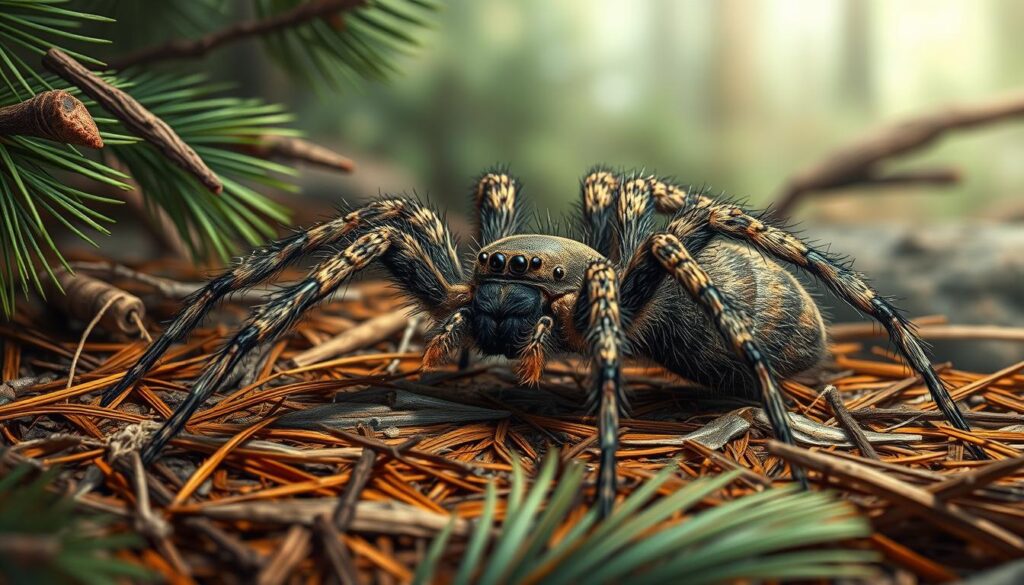
Gardening and Pest Control: The Carolina Wolf Spider’s Role
If you garden or own a home in the southeastern United States, you might have seen the Carolina wolf spider. This North American arachnid is not just interesting to watch. It also helps control pests in your garden.
The Carolina wolf spider is a great predator. It eats small insects, crickets, and other tiny creatures. By doing this, it keeps your garden healthy. This means you might not need to use chemical pesticides as much.
Knowing about the Carolina wolf spider can help gardeners. These arachnids live in many places, like forests and gardens. They help control insect populations and keep your plants healthy.
| Pest Control Benefit | How the Carolina Wolf Spider Helps |
|---|---|
| Reducing Insect Damage | Feeds on a variety of small invertebrates, including garden pests like crickets, beetles, and other insects |
| Promoting Ecosystem Balance | As a natural predator, helps to control and maintain the population of other small animals in the garden |
| Minimizing Chemical Pesticide Use | Provides a sustainable, eco-friendly alternative to chemical pest control methods |
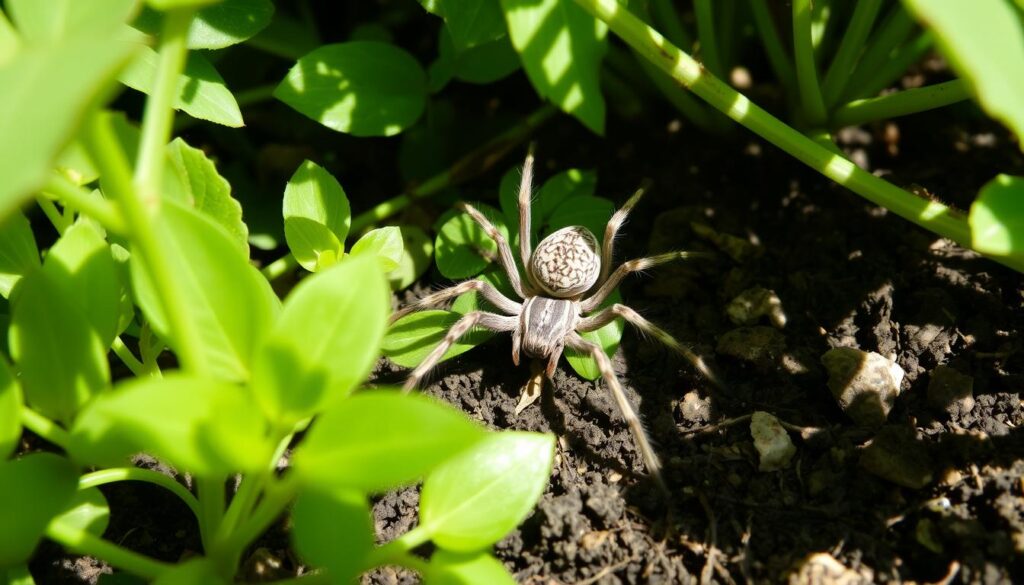
Learning about the Carolina wolf spider can make your garden better. These arachnids help manage pests. With them, you can enjoy your garden more and use fewer chemical pesticides.
Arachnid Behavior: Insights from the Carolina Wolf Spider
The Carolina wolf spider, part of the Lycosidae family, shows fascinating behaviors. These behaviors give us insights into arachnids. By studying this spider, we learn more about their social and ecological lives.
Hunting Strategies
Carolina wolf spiders are great hunters. They use their sharp eyes and quick moves to catch prey. They chase down small insects and even small animals. Learning about their hunting can help us understand wolf spiders’ role in ecosystems.
Territoriality and Courtship
Carolina wolf spiders are very territorial. They defend their hunting spots and nests from others. Their courtship dances and chemical signals show their social side. Watching these behaviors helps us understand wolf spider social interactions.
Reproductive Habits
The way Carolina wolf spiders reproduce is interesting. Female spiders carry their eggs and protect them until the spiderlings hatch. Studying their reproductive habits can teach us about wolf spider populations.
By looking at the Carolina wolf spider’s behaviors, we learn more about arachnids. These insights help us appreciate and protect these creatures. They play a key role in North American ecosystems.
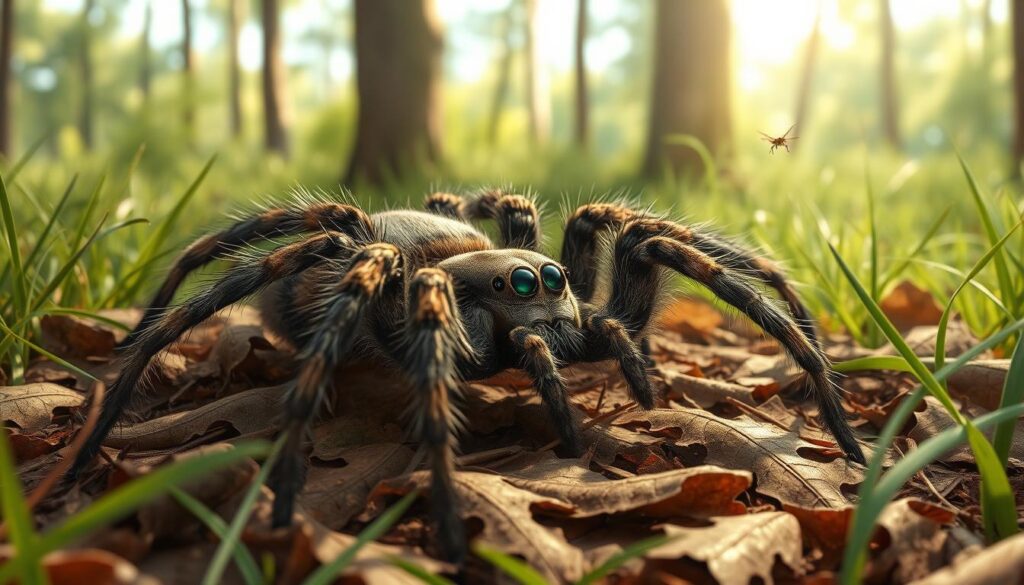
Conservation Efforts and the Carolina Wolf Spider
The Carolina wolf spider, or Hogna carolinensis, is not in danger. Yet, it’s crucial to keep their numbers and homes safe. These spiders are key to their ecosystems and show us how healthy the environment is.
Protecting their natural habitats is vital. This way, we ensure these spiders and the area’s biodiversity stay healthy for a long time.
Some important steps for saving the Carolina wolf spider include:
- Keeping natural places like forests, grasslands, and wetlands safe for them.
- Telling people how wolf spiders help keep pests away and keep the environment balanced.
- Studying these spiders to learn more about them and how to protect them better.
- Working with local groups, landowners, and government to use land wisely and support wolf spider populations.
By doing these things, we can help the Carolina wolf spider stay healthy. This way, they can keep doing their important job in the southeastern United States’ ecosystems.
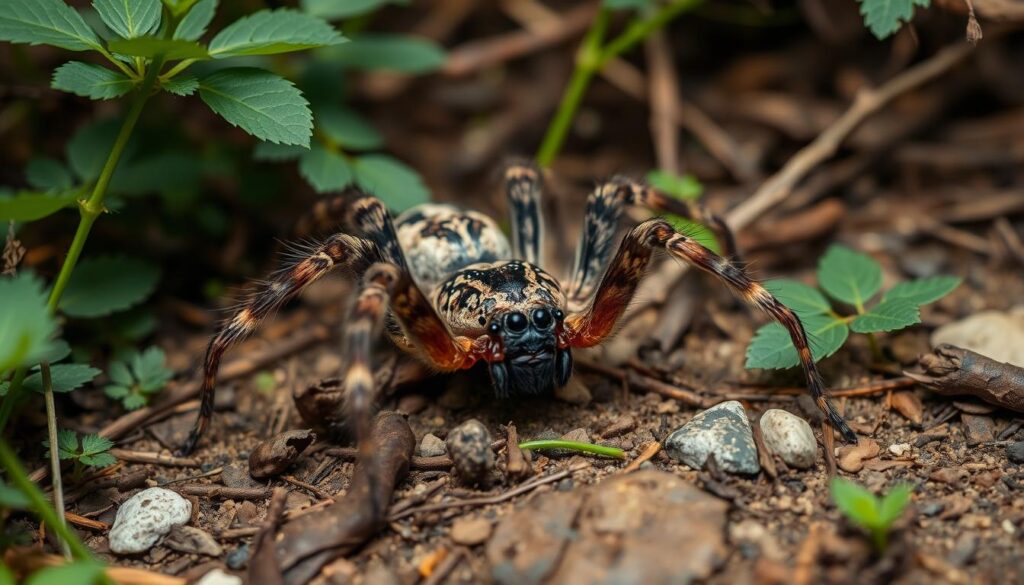
The Carolina Wolf Spider in Popular Culture and Folklore
The Carolina wolf spider, known as Hogna carolinensis, has shown up in popular culture and local stories. These big spiders may not be as famous as some animals, but they’ve caught many people’s interest. They’re often seen as mysterious or scary.
In the southeastern United States, where they live, stories about the Carolina wolf spider are common. These tales tell of the spiders hiding in the dark or watching over hidden treasures. They’re meant to teach and entertain people who know about these spiders.
But, it’s key to know the truth about the Carolina wolf spider. Despite their size and scary look, they’re not venomous. They don’t harm humans. Learning about their real nature helps clear up myths and shows how important they are in Carolina fauna and outdoor pest control.
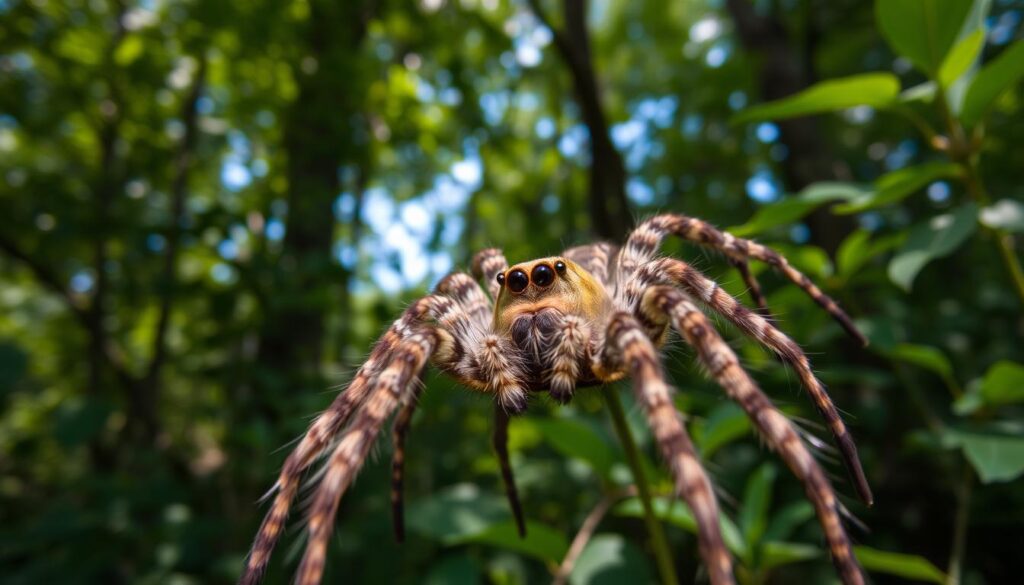
Looking into spider biology and arachnid behavior helps us understand the Carolina wolf spider better. Their stories in popular culture give us a peek into how people see these misunderstood animals. By learning more about these spiders, we can appreciate the rich world of North American arachnids and our shared culture.
Other Notable Wolf Spider Species in North America
The Carolina wolf spider (Hogna carolinensis) is well-known, but it’s not the only wolf spider in North America. Other notable ones include the Backus wolf spider (Hogna helluo) and the Pardosa wolf spider (Pardosa spp.). These spiders are similar to the Carolina wolf spider in how they hunt and where they live.
Learning about different wolf spider species in North America helps us understand these arachnids better. The Backus wolf spider has bright colors, while the Pardosa wolf spider has unique hunting ways. Each species shows a different side of North American fauna.
If you garden or love the outdoors, knowing about wolf spider species is useful. It helps you see how these spiders keep North American ecosystems balanced. By learning about their biology and behavior, you gain a deeper respect for their role in nature.
